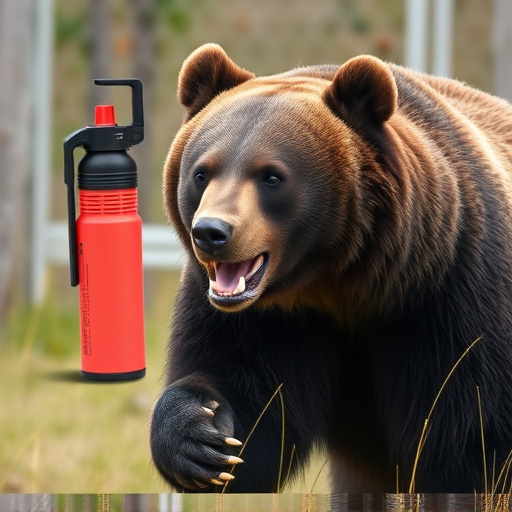Understanding the fog pattern of bear spray is crucial for safe and responsible usage in Alaska. Emitted as a fine mist, it temporarily deters aggressive bears by impairing their smell and vision. The residue's impact on wildlife and ecosystems, however, requires careful consideration. Factors like temperature, humidity, wind speed, and terrain affect the spray's duration and dispersion, with colder conditions prolonging residue. Best practices include aiming at the bear's face, quick movement away, and proper disposal to minimize environmental and wildlife impacts.
Alaska’s rugged landscapes host a diverse ecosystem, including bears. Understanding the guard Alaska bear spray fog pattern is crucial for both safety and environmental impact. This article delves into the science behind bear spray residue, its effects on wildlife and ecosystems, and best practices for responsible use. By exploring these aspects, we aim to mitigate the potential consequences of bear spray, ensuring a harmonious balance between human activities and Alaska’s natural tapestry while prioritizing the well-being of both wildlife and humans.
- Understanding Bear Spray Fog Pattern and Its Purpose
- The Science Behind Bear Spray Residue
- Impact of Bear Spray on Wildlife and Ecosystems
- Mitigating the Effects: Best Practices for Responsible Use
Understanding Bear Spray Fog Pattern and Its Purpose
Understanding the bear spray fog pattern is crucial in assessing its effectiveness and potential wildlife impact, especially in Alaska’s unique ecosystem. When a bear spray device is activated, it releases a fine mist or fog of the chemical agent, designed to deter aggressive bears. This fog pattern plays a vital role in providing a safe barrier for individuals encountering bears, particularly grizzly bears known for their strength and unpredictability.
The primary purpose of this spray residue is to create a temporary yet powerful distraction, disrupting the bear’s sense of smell and vision. The fog pattern allows people to maintain distance and escape potential danger. It’s essential to consider how the spray residue impacts wildlife; while it provides protection, it also highlights the need for responsible usage to minimize environmental harm. Proper understanding and training ensure that individuals can effectively utilize bear spray while mitigating its impact on Alaska’s wildlife.
The Science Behind Bear Spray Residue
The science behind bear spray residue reveals a complex interplay between the chemical composition of the spray and the environmental factors that influence its pattern and impact. Bear spray, when deployed, creates a fog-like cloud that consists of fine droplets containing capsaicin, the active ingredient responsible for its pungent and irritant properties. This cloud doesn’t just dissipate immediately; it interacts with various elements in the ecosystem, leading to the formation of residue.
Understanding bear spray residue is crucial in gauging its effectiveness and potential wildlife impact. The fog pattern can vary based on factors like air temperature, humidity, wind speed, and terrain. In colder conditions, the spray tends to linger longer due to reduced evaporation rates, potentially increasing the likelihood of direct contact with bears. Conversely, warmer temperatures accelerate evaporation, leading to a shorter-lived but more dispersed residue pattern. This variability underscores the importance of context in interpreting both the spray’s immediate effect on bears and its broader ecological implications.
Impact of Bear Spray on Wildlife and Ecosystems
Bear spray, a common defense mechanism used by outdoor enthusiasts and residents in bear-infested areas like Alaska, has both immediate and long-term effects on wildlife and ecosystems. When bears are sprayed, the irritants in the spray cause them to flee, temporarily deterring potential attacks. However, the impact extends beyond the initial reaction. Bear spray residue can remain in the environment, affecting non-target species and ecosystem dynamics.
The residue from bear spray can disrupt the behavior and health of wildlife, with implications for entire ecosystems. For example, birds that feed on insects affected by the spray could experience reduced food sources. Similarly, aquatic life may be impacted if the spray enters water bodies, potentially harming fish and other water creatures. Understanding these indirect effects is crucial in managing bear-human interactions while preserving the delicate balance of wild habitats.
Mitigating the Effects: Best Practices for Responsible Use
When using bear spray, understanding the fog pattern and its behavior is crucial to mitigate the effects on both yourself and the environment. Bear spray residue can linger in the air for several minutes, forming a fog that travels with the wind. This means it’s essential to be mindful of your surroundings and the potential impact on wildlife.
Best practices for responsible use involve ensuring the spray remains within the intended target area. Users should aim for the bear’s face and eyes, keeping their own safety in mind as well. After application, quickly move away from the fogged area to prevent accidental exposure to both yourself and wild animals. Proper disposal of used cans is equally important to minimize wildlife impact, as residual chemicals can be harmful to the environment and local fauna.
Understanding the fog pattern of bear spray and its residue is crucial in mitigating the impact on both wildlife and ecosystems. By following best practices for responsible use, we can ensure that bear spray effectively deters bears without causing harmful effects to these sensitive environments and their inhabitants. Knowing how bear spray residue behaves helps us make informed decisions to protect both bears and humans, fostering a harmonious coexistence.
